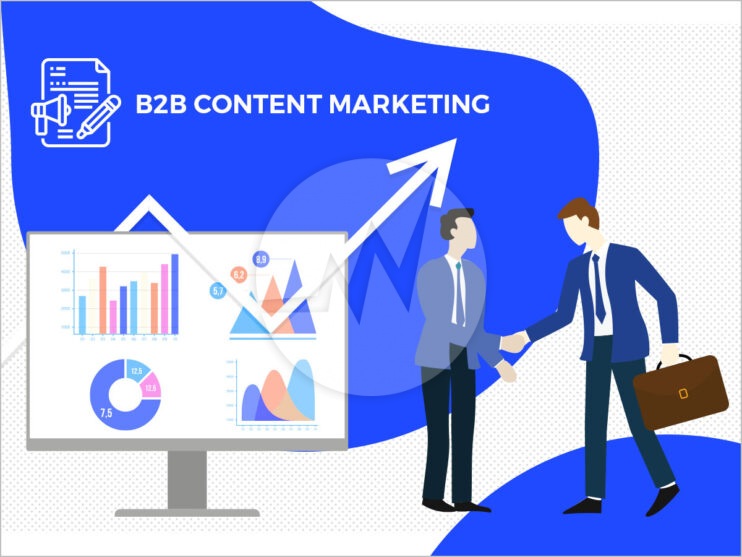How to Build stand out Content Marketing Strategies for B2B Organization?

Content marketing has long been considered an important strategic measure in B2C. Now it is being discovered more and more by B2B – and rightly so, because business customers are already waiting for it.
Strictly speaking, there is no difference between a B2B and B2C content marketing concept. The only difference lies in the requirements of the industry target groups themselves. The fact that B2B providers are now discovering content marketing for themselves is primarily due to the fact that the needs of their target groups have changed.
The annual budget for digital content marketing is significantly higher in B2C than in B2B. The B2C sector has been expanding its image with content marketing for a long time, generating new customers and retaining existing customers, increasing leads and traffic and improving conversion rates on websites. For many B2B providers, however, the type of information management that content marketing entails is still new.
New B2B business model: Push becomes pull
In the past, it was a matter of “tracking down” business customers (or their representatives) in order to then address them directly (analogue). Sales made acquisitions over the phone, through advertising brochures and flyers, or with direct mail. The aim was to invite the potential customer to a meeting in which more in-depth information and options relating to the offer could be passed on.
And this is exactly where the decisive difference to the past lies – Most customers no longer want to be addressed directly. Those interested prefer to get their information themselves first – mostly on the Internet.
Educational content: From product to information marketing!
The need for information is very high, especially for complex products or larger purchasing volumes. After all, there is a great investment risk – which, by the way, is an important difference to B2C. For this reason, the research and decision-making process for buyers takes longer. The expectations of information and its depth are accordingly high.
The “new” demands of B2B target groups require new solutions and approaches in the provision of information. The content has to be easy to find, up-to-date, well researched and presented in a way that is easy to understand.
The current magic word for the industry: Educational Content. This is nothing more than content that is of high quality and aims to “educate” the reader, i.e. to provide the best possible information. This form of content enables companies to position themselves as experts and thus to create authority, credibility and trust. In addition, Google recognizes high-quality content and “rewards” it with a better ranking.
Speaking of Google: Before producing the content, an extensive SEO analysis include keyword research on the most important search terms of the target groups should be carried out. The search terms used by customers may in part differ from the company-specific (and internally requested) terms.
Website and formats intended for business customers
Another difference to B2C is that the website plays an even bigger role in B2B. In the past, the website of companies that maintained relationships with other companies functioned primarily as an archive for press releases, brief information in the catalogue as a prominent contact point for sales.
The B2B website should primarily address the new demands of the target group. It should therefore provide a direct overview of products, solutions as well as their functionalities and their usability. Content should move away from product marketing towards relevant information marketing. The customer’s need for information takes precedence over the company’s advertising messages. Values and visions can also be conveyed through practical experience of users or interviews with customers.
B2B touchpoints: Social media has come of age!
Creating high quality content in user-generated formats is important. It is at least as important that the content is visible to the target group.
In addition to SEO as the most important pull measure of the website, push measures should also be used. B2B buyers search for information on different channels depending on the industry, depending on their age, but also depending on the research phase. At the so-called touchpoints, providers can position their information and thus draw the attention of new customers to themselves.
Social media has grown up as a point of contact. Between September 2017 and October 2018 alone, the number of social media users grew by 320 million. According to study, around 70 percent more budget will be invested in social media marketing in the next five years.
Seed the trust for business customers: Native advertising
For the best possible performance of the content, targeted seeding, i.e. targeted distribution of the content with a marketing budget, is also recommended. Classic B2B measures such as email marketing and social media marketing are generally recommended. From a content marketing perspective, native advertising is particularly exciting. The content adapts to the media in which it is placed and is thus less clearly perceived as advertising. Especially the B2B content, which contains sophisticated information content, can be spread so delicately and in line with its intention.
A final recommendation: B2B providers who have not yet tailored their digital content to the new requirements of their target groups can drop out at an early stage in the purchase decision process. It is often younger, smaller companies that process their information better digitally and thus snatch customers away from the big and well-known brands. It is important that the provision of information starts as soon as possible.
If you are looking for content marketing strategies, content writing, SEO content marketing, SEO, online marketing, social media marketing, search engine optimization services, digital marketing services, PPC campaign management service and more, Please Explore our SEO Services!



